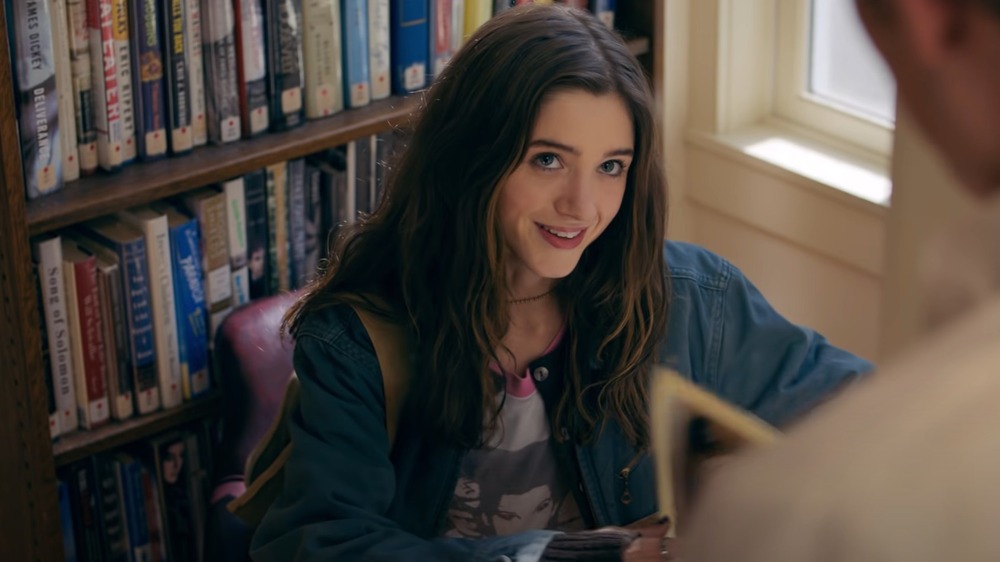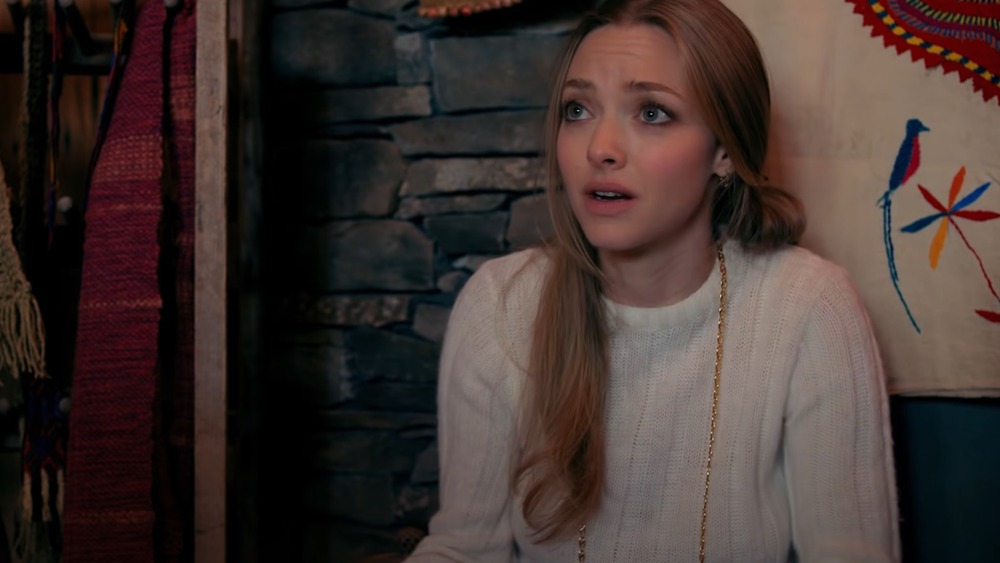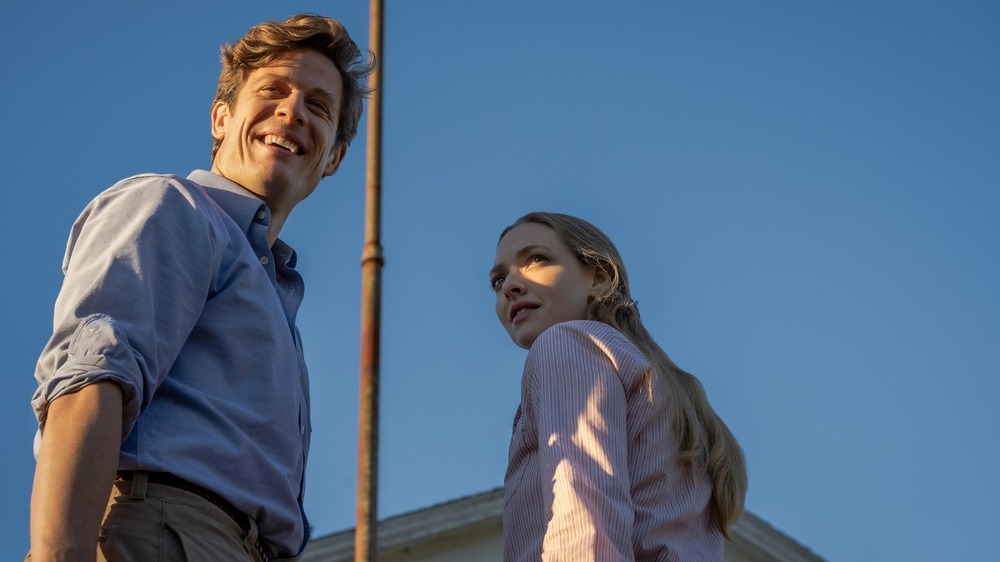It's Time To Talk About Natalia Dyer And Amanda Seyfried In Things Heard & Seen
This content was paid for by Netflix and created by Looper.
Life on the farm takes on a bitter new meaning in Things Heard and Seen. Directors Shari Springer Berman and Robert Pulcini's latest film transports audiences to the idyllic Hudson Valley in upstate New York, where the young Clare family relocates from the big city to start a new life on a sheltered but beautiful old farm. But their house has a lot of secrets, and so does the family patriarch, George (James Norton). As his wife, Catherine, investigates the morbid history of the people who lived on the remote property before them, she also uncovers some grim truths about her own husband. Soon, George's web of deception begins to affect her and their new acquaintances in very dark ways.
Leading the cast of this gripping thriller is Mank star Amanda Seyfried, whose haunting portrayal of the talented but troubled Catherine anchors the unnerving story. However, her character is just one of the several women who are impacted by George's lies. Stranger Things' Natalia Dyer is another as Willis, George's reluctant young lover.
Though Catherine and Willis only cross paths indirectly, they have a lot more in common than they might realize. Throughout the film, both Seyfried and Dyer shine as individual performers, but there are a couple of scenes in particular that showcase the subtle connections between their characters and, thus, the cyclical nature of George's duplicity.
An artful callout
One of the earliest signs that George is not who he appears to be comes along when he first meets Willis, an unassuming local college student. Unlike Catherine and the other people in George's life, Willis reads him like a book right away — which is rather appropriate, considering their first encounter takes place in a library.
Of course, Willis' initial reaction to George is easily justified. He's hardly a Casanova. Immediately after meeting Willis, George launches into a creepy anecdote about the artist Caravaggio, who murdered someone over a game of tennis. Willis seems bemused, especially after George reveals that he plays tennis, too. During this scene, Dyer injects Willis with quiet attitude and wit. Willis is quick on her feet — "Well, I hope you're a better loser than Caravaggio," she quips — and Dyer's shifty mannerisms and pointed facial expressions subtly convey her disinterest in the older man. Dyer's line readings accomplish a lot, too. When Willis reveals that she already knows who George is — and, more importantly, who his wife is — it's clear that is she is not impressed by George's awkward come-ons.
What happens next is an even bigger testament to Dyer's talent. Dyer imbues Willis with sweetness when she meets George's daughter Franny (Ana Sophia Heger). As Willis reads Franny a pointed passage from The Cat in the Hat, Dyer's delivery toes the line between being kind to the child and sending a harsher message to George.
Underlying it all, though, is the tiniest hint of sassy flirtation, which gives the character the flexibility to change her mind later, when George and Willis meet again under different circumstances. Dyer's ability to be both playful and stern is impressive, and creates a character that remains enigmatic while still being grounded and relatable.
Weaving a pattern
Later in Things Heard and Seen, we find out a bit more about George's romantic history. Catherine confides in George's co-worker Justine Sokolov (Rhea Seehorn), that she has a "conflicted" relationship with George. As the two tour Justine's room of looms, Catherine reveals that she lost agency in her relationship after she became pregnant with Franny, which was unplanned.
As Catherine explains how she feels like she doesn't have any control over her life, Seyfried layers her lines with tinges of regret and sadness while still maintaining the character's strong sense of duty and commitment to her family. Catherine's mood visibly brightens when Justine invites Catherine to join a friendly group of creative women, and Seyfried plays the scene like a woman who can finally exhale. At long last, there's hope that she'll be seen.
It still takes a while for the full tapestry of George's lies to come to light. But this early scene, in which Catherine is surrounded by a bunch of literal threads, tells us who this character is, how she's found herself in these circumstances, and what she really thinks of the man she's sharing a life with. This insight into Catherine's discomfort also paints a picture of who Catherine and George were before the movie began, and Seyfried's performance lets the audience know that the bones of Catherine's marriage, much like those of her house, aren't as strong as they seem.
A grim portrait
In both scenes, Dyer and Seyfried have to give their characters duality, while also shedding light on their shared love interest, George. It's a tricky balance, but both actresses pull it off. Dyer plays a person who is wise to George's game right from the start and who doesn't want anything to do with him — and yet she doesn't completely close the door on him, either. Meanwhile, Seyfried's scene showcases her character's quiet suffering and the sense that she needs to reclaim her own identity, while hinting that she hasn't quite reached a point of full-on defiance or distrust quite yet.
Taken together, both scenes reveal two very different sides of George's relationships with women. Though we don't actually see the moment when Catherine first meets George, we can surmise that it might've gone a little something like what happened between him and Willis. After all, George first tries to bond with Willis over a book of artwork — and, as we know, Catherine is a talented restoration artist. She really might have been charmed by a swaggering, boastful art lesson.
At the same time, the actresses are careful to show us that these two characters have very different personalities. That makes all the difference when it comes to their ultimate fates. Even though Willis ultimately accepts George's advances, she's fully aware of who he is, and calls things off before he begins to control her. However, Catherine has a sense of "Catholic" duty to George once Franny is born. By the time that Catherine realizes she's no longer steering the ship of her own life, she's already isolated in the remote farm house, with few friends and no career. It's much more difficult for her to course correct.
In both cases, Dyer and Seyfried are fully present in their performances, painting portraits of two very different women in the orbit of the same dangerous man. Even though they never share the screen, Catherine and Willis' storylines are hopelessly intertwined, and the actress' contrasting choices in scenes like these go a long way towards making Things Heard and Seen's dichotomy work.


